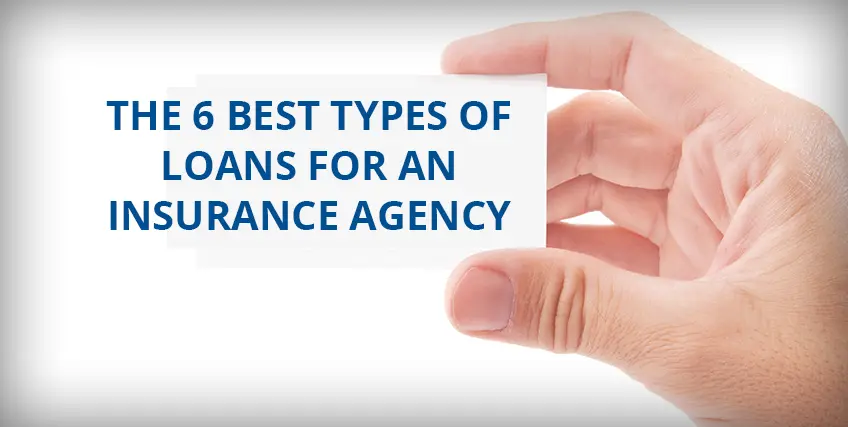Apply Now for Quick and Reliable
Loans for Insurance Agents
Grow your insurance agency with trusted financing solutions from Biz2Credit.
Looking for Business Financing?
Apply now for flexible business financing. Biz2Credit offers term loans, revenue-based financing, lines of credit, and commercial real estate loans to qualified businesses.
Set up a Biz2Credit account and apply for business financing
Unlock Business Potential with Loans for Insurance Agents
The financial landscape for insurance agents presents a unique blend of challenges and opportunities, making access to an array of financing solutions essential for business growth. Unlike traditional businesses, insurance agencies often face fluctuating cash flows due to commission-based income, seasonal sales cycles, and delayed payments from policy renewals. These factors can make it difficult to cover operational costs, invest in marketing, or expand client services. This is where loans for insurance agents play a crucial role.
Designed to address the specific financial needs of insurance professionals, these loans provide the working capital necessary to manage day-to-day expenses, upgrade technology, hire staff, or explore new markets. Traditional lending institutions may view commission-based income as unpredictable, often leading to stricter loan requirements or limited access to funds. However, alternative lenders and specialized financing providers recognize the potential and stability within the insurance sector, offering flexible insurance agency financing with faster approval times and adaptable repayment structures.
Additionally, access to funding empowers agents to invest in digital marketing, enhance customer engagement, and diversify service offerings to remain competitive in a dynamic market. For independent agents and small agencies, these financing solutions can bridge the gap between financial strain and long-term success. Ultimately, loans for insurance agents provide a financial safety net and growth catalyst, helping professionals in this industry overcome income volatility while capitalizing on opportunities for business development and expansion.
Why Biz2Credit Stands Out as a Top Choice for Loans for Insurance Agents?
Biz2Credit is a trusted financial partner for insurance agents seeking reliable and flexible funding solutions to support and grow their businesses. Understanding the unique financial dynamics of the insurance industry such as commission-based income, seasonal revenue shifts, and delayed client payments, Biz2Credit offers customized financial products designed to address these challenges. Whether it’s managing operational expenses, expanding client outreach, or investing in marketing strategies, we provide quick access to capital with fast funding decision. This allows insurance agents to focus on what they do best, serving clients and growing their agencies, without worrying about cash flow interruptions.
What sets Biz2Credit apart is its personalized approach to insurance agency financing. The platform offers a variety of funding options with flexible repayment terms, ensuring agents can access the right financial support without overextending their resources. Biz2Credit's technology-driven process streamlines funding access, providing a seamless and transparent experience from application to disbursement. Additionally, agents benefit from working with dedicated funding specialists who understand the insurance industry and can recommend solutions tailored to each agency’s specific needs and growth goals.
Biz2Credit empowers insurance professionals to invest in their business whether by upgrading technology, hiring additional staff, or launching new marketing campaigns without the typical hurdles of traditional financing. With its commitment to quick access to capital, personalized service, and deep industry insight, Biz2Credit stands out as a top choice for loans for insurance agents, seeking dependable financial solutions to achieve long-term success.
Our Strengths:
- Repayment Simplicity: We have simple repayment options for loans for insurance agents with flexible repayment terms. See your loan payment schedule and make payments any time in your Biz2Credit account.
- Dedicated Funding Specialists: Consult a funding specialist to determine what type of financing options for insurance agents fit your business best or get help at any time along the way as you complete our online funding application.
Diverse Solutions for Loans for Insurance Agents
Insurance agents operate in a dynamic industry where consistent cash flow and strategic investments are essential for business growth. Various business loans for insurance agents are available to manage operations, expand services, and capitalize on market opportunities. Understanding the different types of loans for insurance agents can empower business owners to choose the right support for their unique needs.
There are many types of funding available in the market that insurance agencies can opt for. SBA loans for insurance agencies can be used to manage working capital and are ideal for handling daily operational expenses, covering payroll, or bridging cash flow gaps during slow seasons. Business lines of credit are also offered by lenders to provide flexible access to funds, allowing agents to withdraw only what they need and pay interest solely on the amount used, making it perfect for handling unexpected costs or seizing new opportunities. For agents looking to expand their operations, equipment financing can help purchase or upgrade office technology, software, and other essential tools to improve efficiency and client service.
Additionally, commercial real estate financing allows agents to invest in new office space or renovate existing premises, enhancing their professional image and accommodating business growth. Insurance agency acquisition loans provide financing solutions to help entrepreneurs and businesses purchase established insurance agencies, ensuring smooth transitions and growth opportunities. Merchant cash advances provide quick access to funds based on future earnings, which can be especially useful for agents dealing with commission-based income and seasonal fluctuations.
By leveraging these funding solutions, insurance agents can invest in marketing campaigns to attract more clients, hire additional staff to scale operations, or diversify their service offerings to stay competitive. Access to the right financial support ensures agents can navigate challenges, seize growth opportunities, and build a thriving, resilient business.
Types of Financing Solutions for Insurance Agents Offered by Biz2Credit
Growing and managing an insurance agency requires strategic financial support to overcome industry-specific challenges. At Biz2Credit, we offer different types of funding solutions like term loans, revenue-based financing, and commercial real estate loans, designed to help insurance agents stay competitive and achieve long-term success. Whether you’re aiming to invest in advanced technology to enhance client engagement, scale your operations by hiring additional staff, or expand your office space to accommodate growth, our flexible financial options are built to support your business goals.
1. Term Loans for Insurance Agents
Term loans can provide the essential support insurance agencies need to achieve consistent growth and long-term success. This funding option offers upfront capital with fixed payments, making it easier to plan finances and maintain steady cash flow. It’s ideal for significant investments like upgrading client management systems, enhancing digital marketing efforts, or expanding office space to support a growing team and client base.
Additionally, this flexible funding can be used to strengthen marketing campaigns, hire new agents during busy seasons, or increase working capital to keep daily operations running smoothly. Biz2Credit offers personalized loans for insurance agents with competitive terms, a simple application process, and expert guidance designed to help insurance agents succeed. Our goal is to support your agency’s growth by providing the resources needed to stay competitive, attract new clients, and deliver outstanding service, all while building a strong foundation for future success.
Eligibility Criteria:
- A credit score of 650 and above.
- At least 18 months in business.
- Annual revenue of $250,000 or more.
2. Revenue-Based Financing for Insurance Agents
For insurance agencies seeking adaptable financial support, revenue-based funding provides a solution that aligns seamlessly with fluctuating cash flow. Instead of fixed monthly payments, your payment amount is calculated based on a percentage of estimated future receivables.
This type of funding can be used to address critical business needs, such as hiring additional agents during peak enrollment periods, investing in advanced client management systems, launching targeted marketing campaigns, or covering unexpected operational costs. Biz2Credit’s revenue-based financing offers quick access to working capital, allowing your agency to take advantage of growth opportunities or manage challenges without the pressure of rigid repayment schedules. Our flexible approach provides the financial stability and confidence your agency needs to remain competitive and continue growing.
Eligibility Criteria:
- A credit score of 575 and above.
- A minimum of 12 months in operation.
- Annual revenue of $250,000 or more.
3. Commercial Real Estate Loans for Insurance Agents
Insurance agencies aiming to expand, relocate, or upgrade their office space can benefit from Biz2Credit's flexible commercial real estate loans. This type of funding is perfect for acquiring new office locations, refinancing existing properties, or completing major renovations to create a more modern, efficient workspace. Whether you're moving to a larger office to support a growing team or revamping your current space to improve workflow and client engagement, Biz2Credit provides the capital needed to bring your vision to life.
Beyond basic property upgrades, this loan for insurance agents can also be used for strategic enhancements such as designing professional meeting rooms for client consultations, upgrading security systems to protect sensitive client information, or creating welcoming, client-centric spaces that enhance your agency's reputation. These improvements not only streamline operations but also contribute to higher client satisfaction and long-term business growth.
At Biz2Credit, we offer competitive rates and flexible repayment options to support your agency’s expansion goals while maintaining financial stability. Our experienced team is dedicated to providing personalized guidance and a smooth funding process, ensuring you can focus on growing your business without financial roadblocks.
Eligibility Criteria:
- A credit score of 650 and above.
- Minimum 18 months in business.
- Property as collateral.
- Annual revenue of $250,000 or more.
How Can you Utilize Loans for Insurance Agents?
Running a successful insurance agency requires strategic investments and effective financial management. Insurance agents can easily access the capital needed to grow their business, manage daily operations, and stay competitive in a dynamic market with personalized financing solutions. Here’s how insurance agents can make the most of flexible funding options:
1. Expand Office Space - Upgrade or relocate to a larger office to accommodate a growing team and improve client interactions in a more professional setting.
2. Invest in Technology and Software - Adopt advanced customer relationship management (CRM) systems, data security tools, and automation software to streamline operations and enhance client services.
3. Boost Marketing Efforts - Use loans for insurance agents to fund marketing campaigns, including digital advertising, social media outreach, and community events, to attract new clients and increase brand visibility.
4. Hire and Train Staff - Recruit and onboard additional agents or support staff during peak seasons and invest in employee training to improve productivity and service quality.
5. Manage Cash Flow Gaps - Cover operational expenses through business loans for insurance agents during slow seasons or delayed commission payments to ensure smooth day-to-day operations
6. Diversify Service Offerings - Introduce new insurance products or expand into niche markets to attract a broader client base and increase revenue streams.
7. Enhance Office Infrastructure - Renovate existing office spaces with modern amenities, create dedicated client consultation areas, or improve security systems for sensitive data protection.
8. Cover Unexpected Expenses - Access immediate capital to handle unforeseen costs such as emergency repairs, compliance updates, or sudden market changes.
Trusted by Thousands of Small Business Owners in America.**
Simply because we get what you go through to build a business you believe in.
**Disclaimer: All stories are real, as told by real business owners. Customers do not receive monetary compensation for telling their stories.
From One Entrepreneur to Another: We Get You
We understand what's behind building a business you believe in.
All stories are real, as told by real business owners. Customers do not receive monetary compensation for telling their stories.



Articles on Loans for Insurance Agents
Why Small Construction LLCs May be Underinsured and How to Get It Right
Small construction companies form the backbone of America’s building industry. From roofers to remodelers
Smart Ways an Insurance Agency Owner Can Tech Up
The insurance industry is at a pivotal crossroads. While customer expectations continue to rise
Is Business Interruption Insurance Right for Your Business?
Business interruption insurance protects your small business when unexpected events temporarily halt operations.
From Startup to Scale-Up: Smart Insurance Picks for Small Businesses
Starting and scaling a business involves facing risks at every stage. Protecting your venture with the best business insurance for LLC can help manage those risks.
Crack the Code: Best Loans for an Insurance Agency in 2025
In today’s fast-evolving world of insurance industry, having financial flexibility isn’t just an advantage, it is a necessity
How to Choose the Best General Liability Insurance for LLCs
Setting up a Limited Liability Company is an important step towards preserving your personal assets, as well as protecting the business
How to Choose the Best Loan for Your Insurance Agency
As an insurance agency, there are a lot of reasons why business owners might need an insurance agency loan. For example, you might want to
Business Owner Insurance Policy: What You Need for Complete Protection
Business insurance is one of the top ways to protect the business you worked so hard to build.
How Much Is Liability Insurance for a Small Business
Liability insurance for a small business owner is a crucial safeguard.
FAQs on Loans for Insurance Agents
1. Why do insurance agents need business financing?
Insurance agents often face fluctuating income due to commission-based earnings and seasonal market trends. Loans for insurance agents help bridge cash flow gaps, manage daily operations, and invest in growth strategies. With access to funding, agents can upgrade technology, expand marketing efforts, hire additional staff during peak seasons, and diversify their service offerings. This financial support allows insurance agencies to remain competitive, improve client engagement, and pursue long-term growth opportunities, ensuring stability and scalability in a dynamic industry.
2. How can funding help an insurance agency grow?
Flexible options for funding empower the agencies to invest in critical aspects of business development. This includes launching targeted marketing campaigns, expanding office space, hiring and training new employees, and adopting advanced client management systems. It also helps cover operational expenses during slow seasons or periods of delayed commissions. By strategically utilizing loans to buy an insurance agency, agents can enhance efficiency, reach more clients, and introduce new services, leading to sustainable business growth and higher profitability.
3. How difficult is it for insurance agents to qualify for business financing?
Traditional lenders might not provide funds quickly. But alternative financing providers like Biz2Credit offer more flexible qualification criteria, focusing on business revenue, creditworthiness, and growth potential. With simplified applications and quicker funding decisions, these solutions make it easier for insurance agents to secure the capital they need to expand operations, manage cash flow, and invest in business improvements.
Term Loans are made by Itria Ventures LLC or Cross River Bank, Member FDIC. This is not a deposit product. California residents: Itria Ventures LLC is licensed by the Department of Financial Protection and Innovation. Loans are made or arranged pursuant to California Financing Law License # 60DBO-35839









